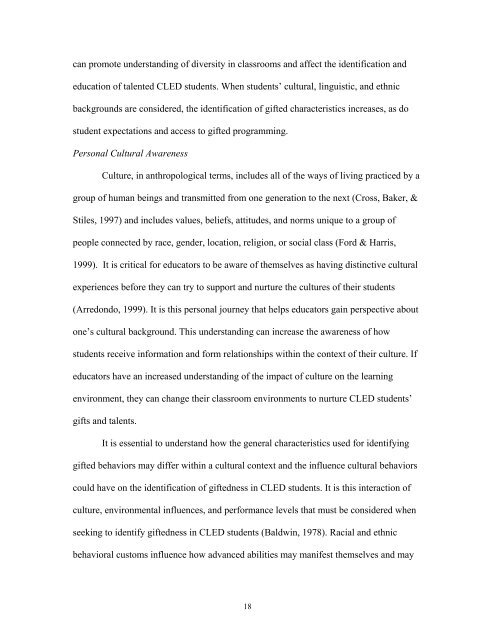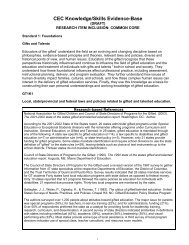Chapter One An Introduction to the Topic of Cultural Diversity - NAGC
Chapter One An Introduction to the Topic of Cultural Diversity - NAGC
Chapter One An Introduction to the Topic of Cultural Diversity - NAGC
Create successful ePaper yourself
Turn your PDF publications into a flip-book with our unique Google optimized e-Paper software.
can promote understanding <strong>of</strong> diversity in classrooms and affect <strong>the</strong> identification and<br />
education <strong>of</strong> talented CLED students. When students’ cultural, linguistic, and ethnic<br />
backgrounds are considered, <strong>the</strong> identification <strong>of</strong> gifted characteristics increases, as do<br />
student expectations and access <strong>to</strong> gifted programming.<br />
Personal <strong>Cultural</strong> Awareness<br />
Culture, in anthropological terms, includes all <strong>of</strong> <strong>the</strong> ways <strong>of</strong> living practiced by a<br />
group <strong>of</strong> human beings and transmitted from one generation <strong>to</strong> <strong>the</strong> next (Cross, Baker, &<br />
Stiles, 1997) and includes values, beliefs, attitudes, and norms unique <strong>to</strong> a group <strong>of</strong><br />
people connected by race, gender, location, religion, or social class (Ford & Harris,<br />
1999). It is critical for educa<strong>to</strong>rs <strong>to</strong> be aware <strong>of</strong> <strong>the</strong>mselves as having distinctive cultural<br />
experiences before <strong>the</strong>y can try <strong>to</strong> support and nurture <strong>the</strong> cultures <strong>of</strong> <strong>the</strong>ir students<br />
(Arredondo, 1999). It is this personal journey that helps educa<strong>to</strong>rs gain perspective about<br />
one’s cultural background. This understanding can increase <strong>the</strong> awareness <strong>of</strong> how<br />
students receive information and form relationships within <strong>the</strong> context <strong>of</strong> <strong>the</strong>ir culture. If<br />
educa<strong>to</strong>rs have an increased understanding <strong>of</strong> <strong>the</strong> impact <strong>of</strong> culture on <strong>the</strong> learning<br />
environment, <strong>the</strong>y can change <strong>the</strong>ir classroom environments <strong>to</strong> nurture CLED students’<br />
gifts and talents.<br />
It is essential <strong>to</strong> understand how <strong>the</strong> general characteristics used for identifying<br />
gifted behaviors may differ within a cultural context and <strong>the</strong> influence cultural behaviors<br />
could have on <strong>the</strong> identification <strong>of</strong> giftedness in CLED students. It is this interaction <strong>of</strong><br />
culture, environmental influences, and performance levels that must be considered when<br />
seeking <strong>to</strong> identify giftedness in CLED students (Baldwin, 1978). Racial and ethnic<br />
behavioral cus<strong>to</strong>ms influence how advanced abilities may manifest <strong>the</strong>mselves and may<br />
18

















